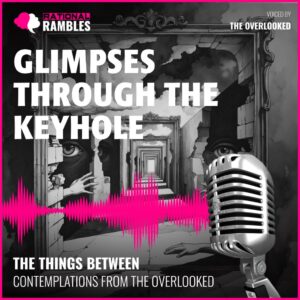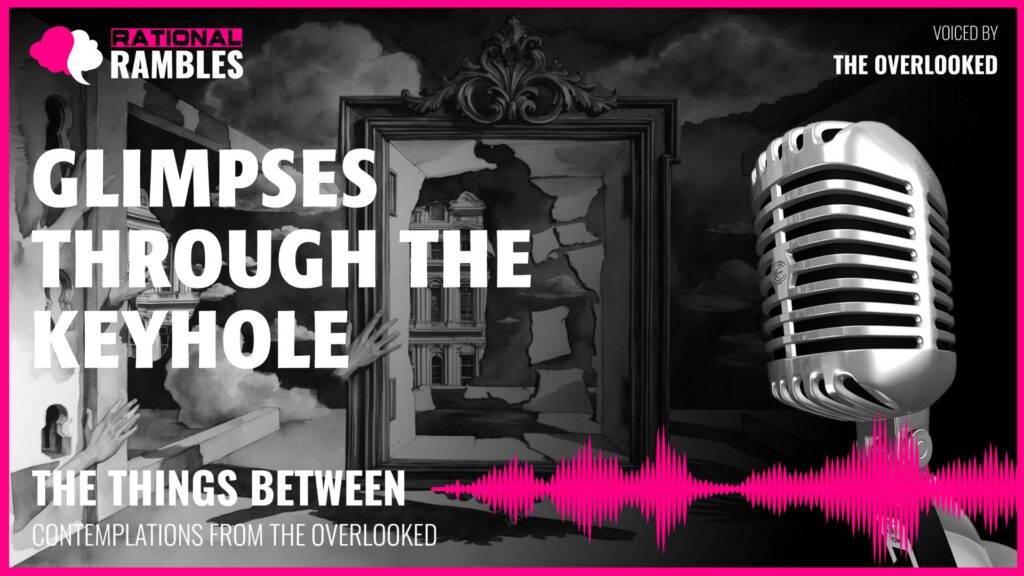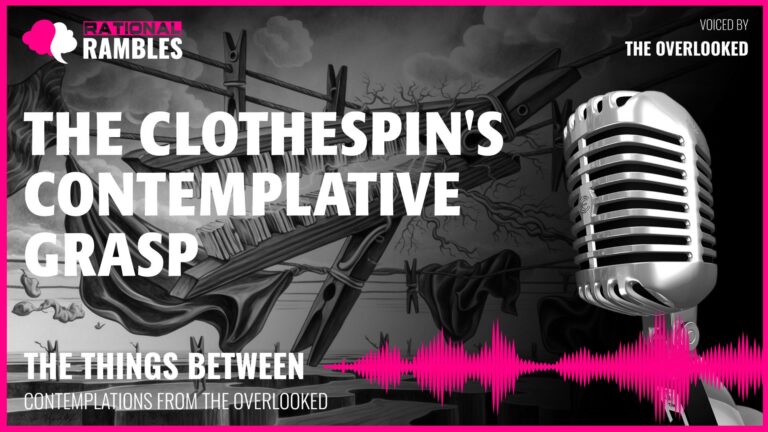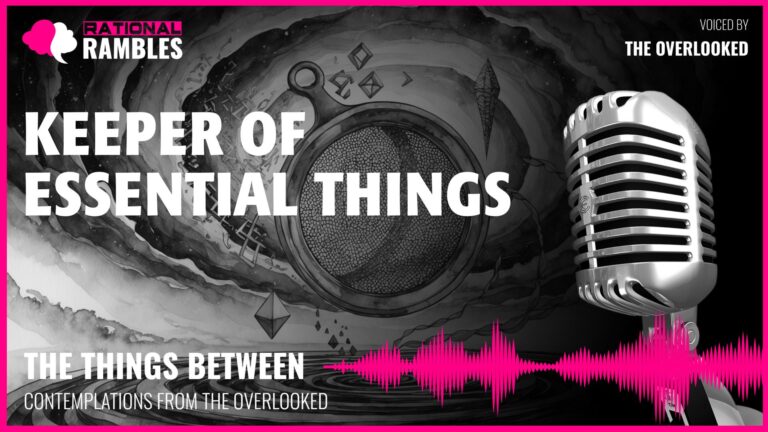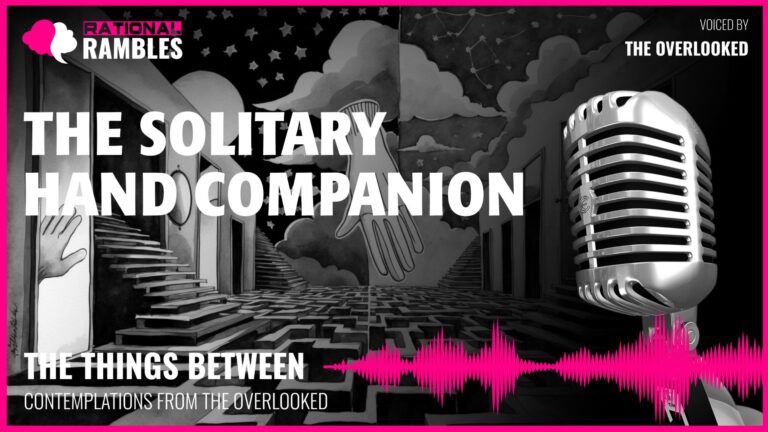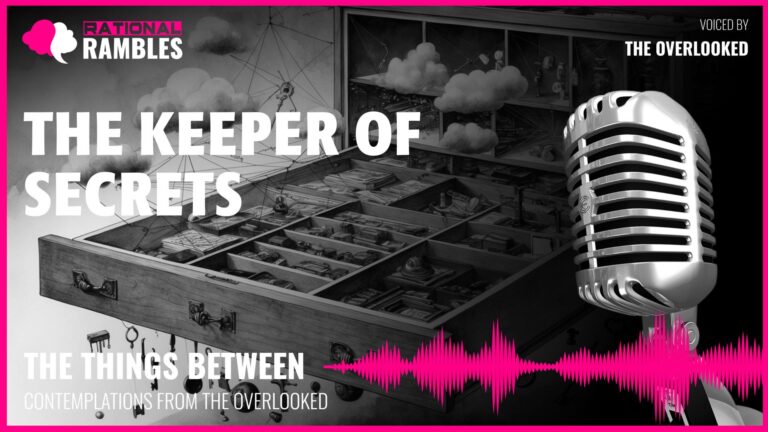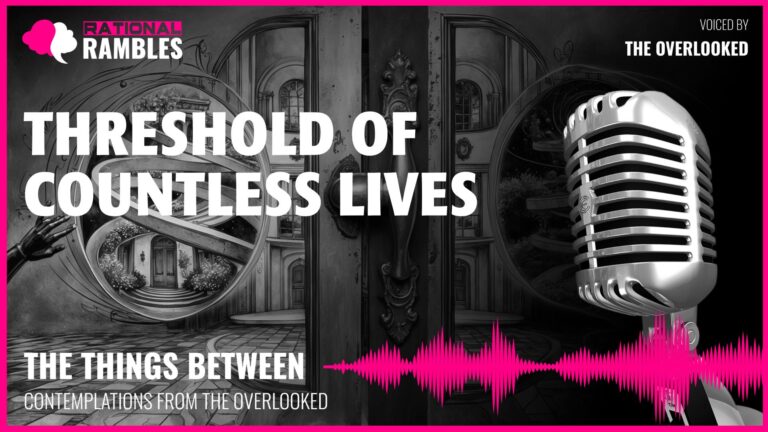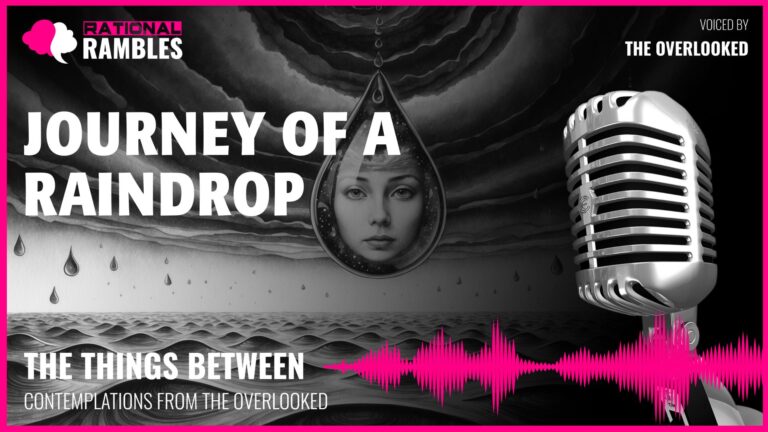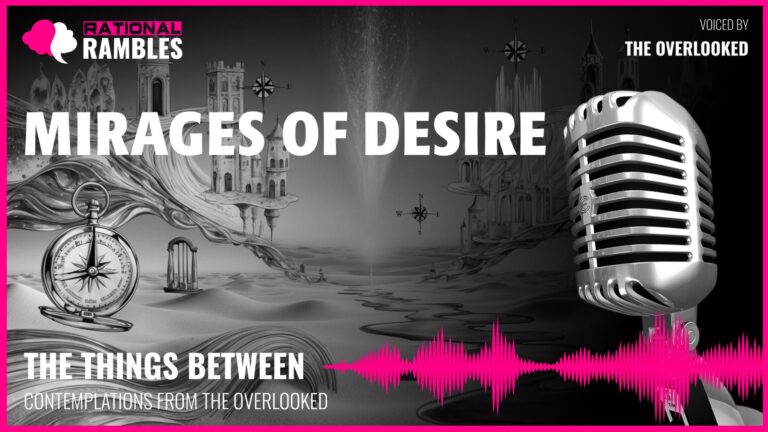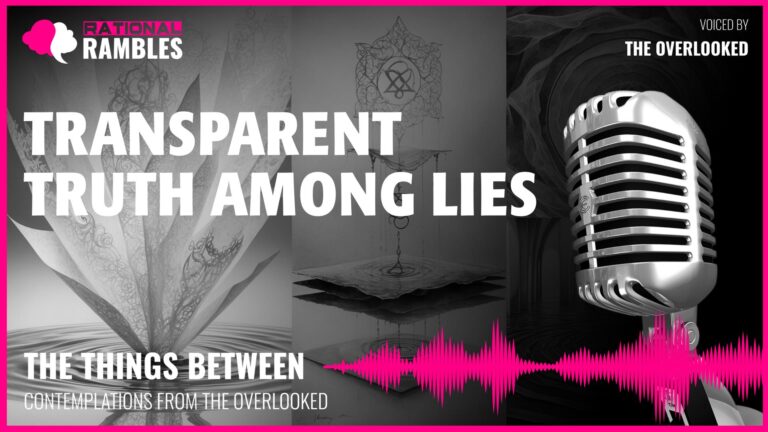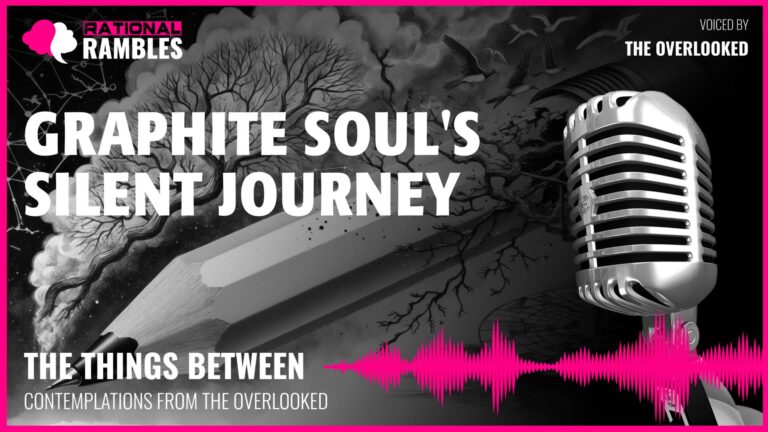Frames of Knowledge: The Epistemology of Limited Perspective
Introduction
At the threshold between knowledge and ignorance lies a fundamental philosophical question: What does it mean to know something partially? The very nature of human understanding is characterized by boundaries and apertures—we grasp reality not in its totality but through limited frames that both reveal and conceal. Our epistemological condition might be likened to peering through a narrow opening, where what we see is genuine yet incomplete, a fragment suggesting a whole that remains beyond our full comprehension.
This peculiar position—existing at the boundary between knowing and not knowing—defines the human cognitive experience. We are beings who simultaneously possess remarkable capacities for understanding while being fundamentally constrained by perceptual, cognitive, and conceptual limitations. These limitations, rather than merely restricting us, may actually constitute the very conditions that make knowledge meaningful and possible.
This article explores the philosophy of limited perspective—examining how boundaries frame our understanding, how partial knowledge shapes our relationship with truth, and how the tensions between revelation and concealment inform our most basic interactions with reality. By investigating the nature of restricted vantage points, we may gain insight into the character of knowledge itself and perhaps discover that the incompleteness of our understanding is not merely a deficit to overcome but possibly the defining feature that gives human knowledge its particular significance.
The Paradox of Partial Knowledge
There exists a deep tension at the heart of human epistemology: our simultaneous desire for complete knowledge and the inescapable partiality of our perspective. We are beings who strive to know everything while being constitutionally incapable of achieving this totalizing vision. This creates what we might call the paradox of partial knowledge—the condition of both valuing comprehensive understanding while necessarily experiencing reality through constrained apertures of perception and cognition.
The Human Desire for Complete Knowledge
Throughout history, humans have demonstrated an insatiable curiosity, a driving impulse to see beyond current horizons of understanding. From the earliest mythologies that sought to explain cosmic origins to contemporary scientific pursuits of unified theories, we find evidence of this persistent desire for total comprehension. The Enlightenment vision of cataloging all knowledge, the scientific ambition to develop a “theory of everything,” and the digital age’s project of universal information accessibility all reflect this fundamental aspiration.
Yet alongside this desire, we have created and maintained countless mechanisms for limiting knowledge. We build doors with restricted viewpoints, encrypt messages, classify information, and establish elaborate systems of privacy. These seemingly contradictory impulses suggest something profound about the nature of knowledge itself—that it may require boundaries to function meaningfully, that unlimited access might undermine rather than enhance understanding.
The Necessity of Limitations
What if limitations are not merely obstacles to overcome but essential features of knowledge itself? Consider what would happen if we could see everything simultaneously, with no constraints on our perspective. In such a scenario, would anything retain its significance? Without frames to direct attention, without boundaries to establish context, information becomes noise—a chaotic sensory overload lacking the structure necessary for meaning.
Immanuel Kant’s transcendental idealism offers one philosophical approach to this problem, suggesting that human knowledge necessarily involves the mind imposing structure on experience. We do not passively receive reality “as it is” but actively organize sensory data through innate categories of understanding. The limitations of these categories are not simply restrictions but the very conditions that make experience intelligible.
Similarly, phenomenologists like Merleau-Ponty have emphasized that embodied perspective is not an impediment to knowledge but its very foundation. To know as humans means to know from somewhere, from a particular position, with a particular orientation. The partiality of perspective is not a barrier to overcome but the necessary condition for any knowledge whatsoever.
Knowledge as Framed Absence
Perhaps most intriguingly, knowledge might be understood not merely as the presence of information but as a particular configuration of presence and absence. What we know is defined both by what is revealed and what remains concealed. The frame—the boundary between what falls within our perception and what lies beyond it—creates the conditions for meaningful apprehension.
This suggests a profound reconceptualization of knowledge: not as absolute illumination but as a kind of structured darkness, a pattern of knowing and not-knowing that creates significance through limitation. The philosopher Hans-Georg Gadamer spoke of the “horizon” of understanding—the boundary that both limits what we can see and makes seeing possible. Without such horizons, vision itself would become impossible, dissolving into an undifferentiated flood of sensory data.
The Metaphysics of Thresholds
Thresholds occupy a strange metaphysical position—they are neither fully one thing nor another but exist precisely at the boundary between states or spaces. Doors, windows, and other liminal structures serve as physical manifestations of this metaphysical condition, embodying the paradoxical nature of boundaries that both separate and connect. By examining the philosophical implications of thresholds, we can gain insight into fundamental questions about identity, relation, and the nature of boundaries themselves.
Liminality and Ontological Status
What is the ontological status of a threshold? It exists in a state of in-betweenness, belonging fully neither to one domain nor another. A doorway is neither completely part of one room nor another but constitutes a third space with its own distinct properties. This liminality challenges our tendency to think in terms of discrete categories and suggests the possibility of entities whose very essence lies in their transitional nature.
The anthropologist Victor Turner famously explored liminality in ritual contexts, describing it as a state of “betwixt and between” where normal structures and hierarchies are temporarily suspended. While Turner focused on cultural transitions, his insights have broader philosophical applications. Thresholds of all kinds—physical, conceptual, temporal—possess this quality of suspended determination, creating spaces where established categories become fluid.
Heidegger’s concept of the “clearing” (Lichtung) offers another approach to understanding thresholds metaphysically. The clearing is neither pure presence nor absence but the opening in which entities can appear as what they are. Like a physical threshold, the clearing makes passage possible—not between physical spaces but between concealment and revelation, between potentiality and actuality.
Boundaries as Creators of Meaning
Far from being merely negative or restrictive, boundaries actively create the conditions for meaning to emerge. Consider how a picture frame transforms the content it surrounds, establishing a context that shapes interpretation. The frame says, in effect, “look here, in this way,” creating a significant difference between what falls within its borders and what lies beyond.
This productive function of boundaries extends beyond physical frames to all forms of limitation. Language works by establishing semantic boundaries, distinguishing one concept from another. Scientific disciplines define their domains of inquiry by what they include and exclude. Even personal identity depends on boundaries—the distinction between self and other, between what constitutes “me” and what does not.
The philosopher Gillian Rose spoke of “the broken middle,” suggesting that meaning emerges not from pure unity or absolute division but from the productive tension of partial connections and separations. Thresholds embody this broken middle, creating spaces where different domains meet without dissolving into one another, where relation occurs precisely through the maintenance of distinction.
The Paradox of Connected Separation
Thresholds present us with a fundamental paradox: they simultaneously connect and separate. A door both joins and divides spaces; a boundary both distinguishes territories and creates the possibility of crossing between them. This dual function challenges simplistic oppositions between connection and division, suggesting instead their mutual dependence.
This paradox has significant implications for how we understand relations of all kinds. In human relationships, for instance, meaningful connection depends on maintaining appropriate boundaries—without some degree of separation, genuine relation becomes impossible. Similarly, intellectual understanding requires both connection (recognizing similarities, establishing patterns) and separation (making distinctions, recognizing differences).
The philosopher Emmanuel Levinas explored this paradox through his ethics of alterity, arguing that genuine relation to the Other requires respecting the Other’s transcendence—their irreducible difference that cannot be fully comprehended or absorbed. The threshold here is ethical: the boundary that both connects us to others and preserves their separateness.
The Epistemology of Glimpses
Human knowledge rarely comes to us as complete illumination but rather as glimpses—fragmentary insights that suggest more than they reveal. This partial quality of understanding has profound epistemological implications, raising questions about how we construct knowledge from limited perspectives and how the character of our knowing is shaped by its inherent incompleteness.
Fragment and Whole: The Hermeneutic Circle
When we glimpse a partial view of something, we immediately begin the work of contextualizing and extrapolating—fitting the fragment into a larger imagined whole. This process exemplifies what hermeneutic philosophers call the “hermeneutic circle”—the cyclical movement between understanding parts in terms of an anticipated whole, while simultaneously revising our conception of the whole based on new understanding of the parts.
Hans-Georg Gadamer described this circular movement not as a vicious circle to be escaped but as the very structure of understanding itself. When we peer through a limited aperture—whether literally through a narrow opening or metaphorically through the constraints of our historical and cultural position—we inevitably engage in this interpretive dance between fragment and whole, between what is seen and what is inferred.
This suggests that all knowledge involves a creative act of completion, a filling-in of what lies beyond our direct apprehension. The philosopher Mary Midgley used the metaphor of a jigsaw puzzle where we must infer the complete picture from a limited number of pieces. The crucial insight is that this inferential process is not merely a deficient substitute for complete vision but the fundamental structure of human understanding.
The Distortion of Perspective
Limited viewpoints do not merely restrict what we see but actively shape how we see it. Just as light passing through a small aperture creates particular patterns of refraction and distortion, knowledge acquired through constrained perspectives undergoes transformations that affect its character. This raises important questions about the relationship between perspective and truth.
Friedrich Nietzsche famously challenged the notion of “perspectiveless knowing,” suggesting that all knowledge is necessarily perspectival—shaped by the position, interests, and constitutive limitations of the knower. Rather than seeing this as a regrettable limitation, Nietzsche suggested it was the inescapable condition of knowledge. “There is only a perspective seeing, only a perspective ‘knowing,'” he wrote, rejecting the very possibility of a “view from nowhere.”
Contemporary feminist epistemologists like Sandra Harding and Donna Haraway have developed similar insights through concepts like “standpoint epistemology” and “situated knowledges.” These approaches recognize that knowledge always emerges from particular social, historical, and embodied positions. The partiality of perspective is not merely a limitation to be overcome but a constitutive feature of knowing that must be acknowledged and critically examined.
The Productive Potential of Partial Knowledge
While the partiality of human knowledge presents certain limitations, it also creates unique possibilities. Limited perspectives can reveal aspects of reality that might remain invisible from a hypothetical “complete” viewpoint. Different angles of vision disclose different features, and the multiplicity of partial perspectives may collectively provide richer understanding than any single totalizing vision.
Consider how specialized academic disciplines develop particular methodologies and conceptual frameworks that illuminate specific aspects of phenomena while necessarily obscuring others. The economist, the historian, the biologist, and the literary critic approach human behavior through different apertures, each revealing patterns that might remain invisible to the others. The richness of human understanding emerges not from transcending these partial perspectives but from their creative juxtaposition and integration.
William James captured this pragmatic view when he suggested that truth is not a static property but something that “happens to an idea” when it successfully guides engagement with reality. On this view, the partiality of knowledge is not merely a limitation but the condition for knowledge to be useful and meaningful within particular contexts and for specific purposes.
Privacy, Secrecy, and the Ethics of Looking
The philosophical examination of limited perspectives inevitably leads to ethical questions concerning privacy, secrecy, and the moral dimensions of observation. How do boundaries between the visible and invisible shape ethical relations? What responsibilities accompany the power to see what others cannot? These questions extend beyond individual ethics to broader social and political considerations about transparency, surveillance, and the right to control access to information.
The Paradox of Privacy
Humans demonstrate a curious ambivalence toward privacy—simultaneously valuing it deeply while constantly finding ways to compromise it, both their own and others’. This contradiction reveals something significant about the nature of privacy itself: that it may not be about absolute concealment but rather about control over the conditions of disclosure.
Privacy philosopher Helen Nissenbaum has proposed the concept of “contextual integrity” to capture this nuanced understanding. On this view, privacy is violated not simply when information is disclosed but when it crosses contextual boundaries inappropriately—when information appropriate in one context is revealed in another where different norms apply. This helps explain why people willingly share intimate details in some settings (with friends, on certain social media platforms) while fiercely guarding the same information in others.
The philosopher Charles Fried argued that privacy creates the “moral capital” necessary for fundamental human relationships like friendship, trust, and love. Without the ability to control what others know about us—to reveal ourselves selectively and progressively—these relationships would be impossible. Privacy thus appears not as opposed to social connection but as its precondition.
The Ethics of Observation
When we have the capacity to observe others without their knowledge—whether through technological surveillance or simply by glimpsing through available apertures—what ethical principles should guide this power? The asymmetry between the observer and the observed creates potential for exploitation, objectification, and violation.
Emmanuel Levinas offers one philosophical approach through his ethics of the face. For Levinas, encountering the face of the Other presents an ethical demand that precedes and grounds all theoretical understanding. The face—vulnerable, expressive, irreducible to mere appearance—commands: “thou shalt not kill” (understood broadly as prohibiting all forms of violence, including the violence of reducing the Other to an object of knowledge).
This Levinasian perspective suggests that observation becomes ethically problematic when it objectifies—when it treats the observed as merely an object of knowledge rather than as a subject whose alterity exceeds what can be seen or known. Ethical observation would recognize the partiality of its perspective and the transcendence of what is observed beyond what can be captured from any single viewpoint.
Michel Foucault’s analysis of the “panopticon” offers a different angle, examining how the mere possibility of being observed alters behavior and constitutes a form of power. When people believe they might be watched, they begin to internalize the external gaze, becoming self-monitoring subjects. This insight raises critical questions about surveillance societies and the political implications of normalized observation.
Secrecy and Transparency in Democratic Societies
At the social and political level, questions about who can see what, and under what conditions, become central to democratic governance. Liberal democracies navigate an essential tension between the need for some measure of governmental secrecy (for security, diplomatic negotiations, etc.) and the democratic requirement for transparency and public oversight.
Political philosopher Sissela Bok distinguishes between legitimate and illegitimate secrets in her work on secrecy and democracy. Legitimate secrets protect important values like privacy, security, and autonomy, while illegitimate secrets primarily serve to shield wrongdoing or maintain unjust power asymmetries. The challenge lies in establishing institutional mechanisms that can distinguish between these types without simply replying on the judgment of those with interests in maintaining secrecy.
The digital age has intensified these tensions, creating unprecedented capacities for both surveillance and transparency. Technologies that enable global communication also facilitate new forms of monitoring; platforms that democratize information access also undermine traditional privacy boundaries. Navigating these developments requires careful philosophical reflection on the values at stake and how they might be balanced in specific contexts.
Beyond Visual Metaphors: Alternative Modes of Knowing
Our exploration of epistemology has thus far relied heavily on visual metaphors—glimpses, perspectives, frames of vision. Yet human knowing extends beyond the visual to encompass many other modes of engagement with reality. By examining alternative epistemological metaphors and non-visual forms of knowledge, we can develop a richer understanding of the diverse ways humans come to know their world.
Tactile Epistemology
Touch offers a fundamentally different model of knowing than vision. Where seeing maintains distance between observer and observed, touching requires intimate contact. Where vision provides a frame that separates what is seen from what remains invisible, touch creates a continuous boundary of sensation between self and world. A tactile epistemology suggests knowledge as contact rather than representation, as direct engagement rather than detached observation.
Maurice Merleau-Ponty explored this alternative through his concept of “flesh” (chair)—a term designating the fundamental continuity between perceiver and perceived. In tactile knowing, the boundary between knower and known becomes permeable; my hand touching an object is simultaneously touched by it. This reciprocity suggests a more participatory model of knowledge than the distanced observation implied by visual metaphors.
Feminist philosophers like Luce Irigaray have further developed these insights, critiquing the dominance of visual metaphors in Western epistemology as reflective of masculine patterns of knowing that privilege distance and objectification. Irigaray proposes alternative metaphors based on touch, proximity, and fluidity to conceptualize less dominating, more reciprocal modes of understanding.
Auditory Ways of Knowing
Hearing suggests yet another model of knowledge acquisition. Sound surrounds and penetrates us in ways vision cannot. We cannot close our ears as we close our eyes; sound comes to us from all directions simultaneously rather than from a single perspective. An auditory epistemology emphasizes receptivity, immersion, and participation in contrast to the directed, framed quality of visual knowledge.
Walter Ong has explored how cultures with stronger oral traditions develop different patterns of thought than highly literate societies. Where visual/textual knowing tends toward analysis, categorization, and linear thinking, auditory/oral knowing favors synthesis, participatory understanding, and cyclical patterns. Neither is superior, but they cultivate different cognitive capacities and epistemological orientations.
Sound also invites attention to rhythm, resonance, and harmony as epistemological categories. We might understand certain forms of knowledge not as static representations but as attunements—ways of vibrating in sympathy with aspects of reality, of finding resonant frequencies between knower and known.
Knowing Through Narrative and Metaphor
Beyond sensory modalities, humans know their world through narrative structures and metaphorical thinking. Stories organize experience into meaningful patterns, creating coherence among disparate events. Metaphors enable understanding of the unfamiliar through relation to the familiar, generating insight through creative association.
Philosophers like Paul Ricoeur have explored narrative as a fundamental structure of human understanding, arguing that temporality itself becomes human through narrative configuration. We make sense of time—otherwise an abstract succession of moments—by emplotting it, organizing events into meaningful sequences with beginnings, middles, and ends. This narrative knowing operates at individual, cultural, and historical levels.
George Lakoff and Mark Johnson have demonstrated the pervasiveness of metaphorical thinking in everyday cognition. Abstract concepts like time, love, or causation are comprehended through metaphorical extension from embodied experience. This suggests that even our most abstract knowledge remains grounded in bodily engagement with the world, challenging sharp distinctions between “intellectual” and “embodied” knowing.
Intuitive and Contemplative Knowledge
Finally, many philosophical and spiritual traditions recognize forms of knowing that operate beyond discursive reason or sensory perception. Intuitive insight, contemplative awareness, and what Michael Polanyi called “tacit knowing” all suggest ways of apprehending reality that cannot be reduced to information processing or sensory reception.
Henri Bergson distinguished between analytic intelligence, which breaks things into parts and examines them from the outside, and intuition, which enters into direct sympathy with the inner reality of things. Analytic knowledge is partial by definition—it grasps aspects or properties rather than wholes. Intuitive knowledge, by contrast, apprehends the integral nature of what it knows through a kind of internal resonance.
Contemplative traditions worldwide have developed sophisticated methods for cultivating non-discursive awareness—ways of knowing that operate through presence rather than representation, through being rather than having. Such approaches suggest that the most profound knowing may come not through accumulating information but through transforming the quality of attention itself.
The Temporality of Limited Knowledge
Our exploration of limited perspective would be incomplete without considering its temporal dimension. Knowledge unfolds through time, and the way we know is profoundly shaped by temporal structures—by anticipation and retrospection, by the unfolding of understanding through moments of revelation and concealment, by the particular rhythms that characterize different modes of knowing.
The Distortion of Time in Moments of Anticipation
When we glimpse something partially—catching sight of a fragment that suggests a whole, hearing a phrase that implies a complete sentence—we enter a state of anticipation that fundamentally alters our experience of time. Seconds stretch into subjective eternities as we await revelation; attention intensifies and narrows to focus on what might appear next.
This phenomenon reveals something significant about the relationship between knowledge and temporality. The philosopher Edmund Husserl explored this through his concept of “protention”—the way present experience includes an implicit reaching-toward what is about to come. This forward intentionality is not separate from perception but constitutive of it, structuring how we apprehend the unfolding present.
Similarly, Martin Heidegger’s analysis of human being as fundamentally futural—as always already projected into possibilities—suggests that anticipation is not merely a psychological state but an ontological structure. We exist temporally as beings who run ahead of ourselves, whose present is always inflected by what is not-yet. This anticipatory structure shapes not just how we wait for knowledge but how we know at all.
Revelation and Concealment as Temporal Process
Knowledge rarely arrives all at once but unfolds as a temporal process of progressive disclosure. What we know emerges gradually, through sequences of revelation and concealment, appearance and disappearance. This processual quality characterizes both individual learning and the historical development of human understanding.
Heidegger’s concept of aletheia (often translated as “unconcealment”) captures this dynamic. Truth for Heidegger is not a static correspondence between statement and fact but an event—a happening in which entities show themselves from out of concealment. Every revelation simultaneously conceals other aspects; every disclosure establishes new shadows. This interplay constitutes the movement of truth rather than impeding it.
This temporal understanding of knowledge challenges models that treat learning as simple accumulation. We do not merely add facts to a growing stockpile but move through evolving configurations of understanding, each revealing certain aspects of reality while necessarily obscuring others. The history of science exemplifies this pattern—each paradigm (in Thomas Kuhn’s sense) illuminates particular phenomena while rendering others invisible or marginally significant.
Different Temporalities of Knowing
Various forms of knowledge operate according to different temporal rhythms. Scientific understanding tends to proceed through cycles of hypothesis, experiment, and theory revision. Artistic insight often involves long periods of gestation punctuated by moments of sudden illumination. Practical knowledge develops through repeated cycles of action and reflection, gradually refinining technique through embodied experience.
Henri Bergson distinguished between mathematical time (measured in homogeneous units) and duration (lived time experienced qualitatively). Knowledge associated with analytical reason tends to operate in mathematical time—sequential, dividing experience into discrete moments. Intuitive understanding works through duration—grasping patterns that unfold continuously, experiencing the qualitative uniqueness of each developmental moment.
Religious and contemplative traditions offer yet other temporal models of knowing. Mystical insight is often described as transcending ordinary temporality altogether—entering a “timeless moment” or “eternal now” in which knowledge is not acquired progressively but realized suddenly and completely. While such experiences cannot be adequately analyzed within conventional epistemological frameworks, they suggest the possibility of modes of understanding not bound by sequential temporality.
Patience and the Ethics of Temporal Knowing
If knowledge fundamentally unfolds through time, certain ethical and practical implications follow. Genuine understanding requires patience—a willingness to allow insight to develop at its own pace rather than demanding immediate comprehension. This patience goes beyond mere waiting to encompass an attitude of receptive attention, of making oneself available to what gradually reveals itself.
Simone Weil’s concept of “attentive waiting” captures this orientation. For Weil, the highest form of attention involves a paradoxical combination of intense focus and complete receptivity—directing oneself toward reality while suspending the impulse to grasp or possess it. This attention creates the conditions for truth to manifest itself in its own time.
In a culture increasingly characterized by immediacy and information overload, this temporal dimension of knowledge takes on renewed importance. The instantaneous availability of facts does not equate to understanding, which continues to require temporal development—the progressive integration of information into meaningful patterns that can only emerge through sustained engagement over time.
The Paradox of Technological Expansion and Persistent Limitation
Contemporary technology has dramatically expanded human perceptual and cognitive capacities. We now see into realms previously invisible—from the subatomic to the cosmic—and process information at scales and speeds unimaginable to previous generations. Yet despite these extensions, we encounter persistent epistemological limitations that seem inherent to the human condition. This tension between expanded capabilities and enduring constraints raises profound questions about the nature of knowledge and the possibility of transcending our limited perspectives.
Technologies of Extended Perception
Modern technology has created extraordinary extensions of human perception. Microscopes reveal cellular structures and quantum phenomena; telescopes capture light from the earliest moments of cosmic history; brain imaging technologies visualize neural activity; global sensor networks monitor countless environmental parameters simultaneously. These tools dramatically expand what we can perceive beyond the constraints of our biological senses.
Similarly, information technologies extend cognitive capacities. Computers process data at volumes and velocities far exceeding human capabilities; algorithms identify patterns invisible to human analysis; digital networks enable unprecedented sharing of knowledge across spatial and temporal boundaries. Through these extensions, we seem to approach previously unimaginable levels of collective knowledge.
Yet as philosopher Don Ihde has noted, every technological extension simultaneously involves transformation and reduction. Technological mediation never simply amplifies existing perception but qualitatively alters what and how we perceive. The microscope doesn’t just make small things look bigger; it creates a new visual world with its own particular characteristics, limitations, and blind spots.
The Persistence of Boundaries
Despite technological extensions, fundamental epistemological limitations persist. Some appear technological in nature—current instruments cannot detect dark matter directly; computational complexity places certain problems beyond practical solution. Others seem more inherently conceptual or philosophical—the explanatory gap between physical descriptions of brain states and subjective experience; the inability to simultaneously optimize for all valuable parameters in complex systems.
Perhaps most fundamentally, the conditioned nature of human understanding remains. However extended our perceptual apparatus, we still know from particular perspectives, through particular conceptual frameworks, within particular historical and cultural contexts. Technology extends the reach of human knowing without transcending its fundamentally situated character.
This persistence of limitations alongside expanded capabilities suggests that boundaries may be constitutive of knowledge itself rather than merely contingent obstacles to be overcome. As we noted earlier, frames create the conditions for meaning; limitations establish the context within which understanding becomes possible. If so, the dream of unlimited knowledge may be not merely practically unattainable but conceptually incoherent.
New Forms of Unknowing
Paradoxically, technological advancement has not only expanded knowledge but created new forms of unknowing. The complexity of our technological systems increasingly exceeds comprehensive human understanding. Machine learning algorithms make predictions through processes their programmers cannot fully explain; global financial systems operate through interactions too complex for any individual to grasp; the environmental consequences of our technologies unfold in patterns that challenge predictive modeling.
This emergent opacity suggests what some philosophers call “technological sublime”—systems whose complexity generates a kind of conceptual vertigo, exceeding our cognitive capacity to represent them coherently. We find ourselves in the strange position of having created tools that extend knowledge while simultaneously generating new domains that resist complete comprehension.
The philosopher Timothy Morton uses the term “hyperobjects” to describe phenomena so massively distributed across time and space that they cannot be directly apprehended in their entirety—climate change, nuclear radiation, evolutionary processes. Our technologies allow us to detect these phenomena while simultaneously revealing their resistance to complete representation within human cognitive frameworks.
The Value of Acknowledged Limitation
These considerations suggest that wisdom in a technological age might involve not the transcendence of limitations but their conscious acknowledgment and integration. Recognizing the inevitably partial nature of our perspective—even when technologically extended—creates the conditions for more responsible knowledge practices.
Such acknowledgment fosters epistemic humility—an awareness of what we do not and perhaps cannot know alongside what we do know. This humility is not opposed to scientific or technological ambition but complements it, grounding innovation in awareness of its limitations and potential blind spots.
It also creates space for multiple forms of knowledge to be valued. If no single perspective—however technologically enhanced—can provide complete understanding, then diverse approaches become not merely culturally interesting but epistemologically necessary. Scientific, artistic, philosophical, indigenous, and other knowledge practices each illuminate aspects of reality that might remain obscure to others.
Perhaps most importantly, acknowledging limitation shifts our relationship to knowledge itself—from a project of conquest or accumulation to one of ongoing dialogue with a reality that always exceeds our full comprehension. In this dialogue, knowledge becomes less a possession than a form of relationship, less about mastery than about attunement to what both reveals and conceals itself through our partial glimpses.
Conclusion: The Significance of the Frame
Our exploration began with a simple philosophical question about the nature of partial knowledge and has expanded to encompass wide-ranging considerations of epistemology, metaphysics, ethics, and temporality. Throughout this journey, we have encountered a common theme: the profound significance of frames, boundaries, and limitations in constituting meaningful human understanding.
Far from being merely negative constraints to be overcome, limitations emerge as the very conditions that make knowledge possible and meaningful. The frame—whether a physical aperture through which we glimpse fragments of reality or a conceptual structure that organizes our understanding—does not simply restrict vision but creates the context within which seeing becomes significant. The boundary between knowing and not-knowing is not merely a frontier to be pushed back through technological or intellectual progress but a creative edge where meaning itself is generated.
This perspective offers a profound reimagining of the human epistemological condition. Instead of viewing our limited perspective as a deficiency to be transcended, we might recognize it as the distinctive character of human knowing—neither a flaw nor a virtue but simply the mode through which meaning becomes available to beings like ourselves. Our partiality is not merely what we must overcome to know but what constitutes knowledge as we experience it.
Such a view does not counsel complacency or resignation. We can and should extend our understanding, develop new tools and methods, push against current horizons. But we do so not with the aim of achieving some mythical “view from nowhere” but rather with awareness that each new perspective, each expanded frame, each technological extension will continue to be characterized by its particular pattern of revelation and concealment. The development of knowledge is not progress toward unlimited vision but an ongoing reconfiguration of the relationship between what we can see and what remains beyond our sight.
Perhaps most valuably, this understanding fosters an epistemological humility that seems particularly needed in contemporary discourse. Recognizing the inherently partial nature of all human understanding creates space for genuine dialogue across different knowledge traditions, awareness of the limitations of technological solutions, and openness to the possibility that reality always exceeds our conceptual grasp of it.
In the end, we might say that human knowing occupies a space analogous to that of a threshold—neither fully in one domain nor another but at the boundary between them. We stand at the aperture between the known and the unknown, between light and shadow, between revelation and mystery. It is precisely this liminal position—this dwelling at the threshold—that constitutes our distinctive way of being in and knowing the world. Our glimpses are partial, our vision limited, our understanding incomplete—and in this very partiality lies the particular character and significance of human knowledge.


